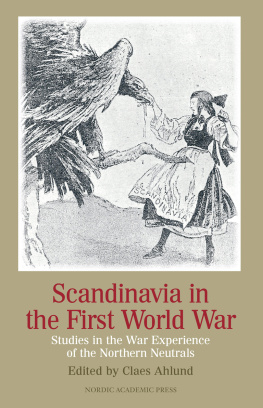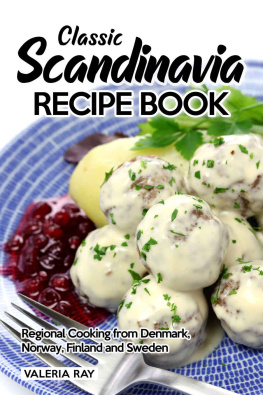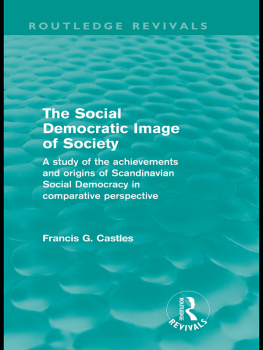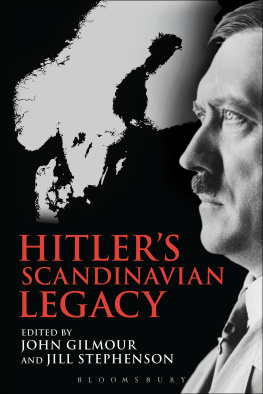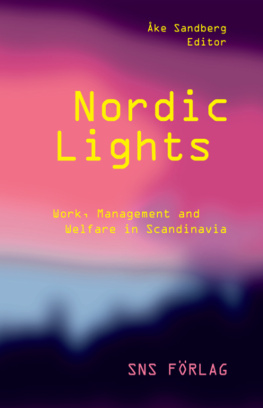Scandinavia in
the First World War
Studies in the War Experience
of the Northern Neutrals
Edited by
Claes Ahlund

NORDIC ACADEMIC PRESS
Nordic Academic Press
P.O. Box 1206
S-221 05 Lund
Sweden
www.nordicacademicpress.com
Nordic Academic Press and the Authors 2012
Jacket design: Maria Jrgel Andersson
Jacket illustration: Caricature in the Danish magazine
Hver 8. Dag, 20 November 1916
Tryckt utgva ISBN 978-91-87121-57-9
E-bok ISBN 978-91-87121-91-3
Preface
This book is about the impact of the First World War on the neutral Scandinavian countries, Denmark, Norway, and Sweden. It offers a series of original analyses in a research field that is well established internationally, but seriously underdeveloped in Scandinavian historiography.
The introduction offers a systematic, comparative view of the history of the Scandinavian countries during the war, along with the general background for the more detailed case studies. The subsequent chapters represent a number of different approaches in history, media studies, and literary studies. Some of them explore how intellectuals tackled the issues raised by the war, or aspects of the military and economic consequences of the war, and a third group deal with the immediate war experience of Scandinavian nurses, seamen, and soldiersvolunteers in the Australian Imperial Force as well as Schleswig Danes mobilized in the German armed forces.
Scandinavia in the First World War is the first major result so far of the international and interdisciplinary Network for the study of neutral Scandinavia in the First World War, which I initiated in 2009 and have since then coordinated. Three network seminars have been arranged: in Uppsala in 2009, in Lund in 2010, and in Uppsala again in 2011, the results of which can be studied in the present volume. Financially, the network has benefited from the generous support of Riksbankens Jubileumsfond and a most welcome publication grant from Sven och Dagmar Salns stiftelse.
Finally, I would like to express my gratitude to Svante Nordin, Karen Gram-Skjoldager, Michael Jonas, and Louise Nilsson, all of whom are members of the network but for various reasons are not among the authors of this book, and who have formulated highly valuable ideas and suggestions in the discussions of the work in progress during the network seminars.
Claes Ahlund
INTRODUCTION
Scandinavia in the First World War
Rolf Hobson, Tom Kristiansen, Nils Arne Srensen & Gunnar selius
In December 1914, the kings of Denmark, Norway, and Sweden met in the city of Malm on the south coast of Sweden to demonstrate Scandinavian unity and a common determination to remain neutral in the ongoing war. At that point, the fighting had not taken a decisive turn on the battlefield. In an indirect strategy, an adjunct to the conventional fighting, the belligerents embarked on trade war and blockade to besiege their enemies economy and society at large. This profoundly changed the character of the war. It also subjected the Scandinavian countries to relentless pressure.
When the war ended four years later, all three countries had indeed succeeded in staying out of the conflict. From that perspective, the Meeting of the Three Kings in Malm in 1914 and the follow-up meeting in the Norwegian capital Kristiania (present-day Oslo) in November 1917 would appear to have been important events. They were certainly perceived as such by contemporaries. In 1914, the Swedish weekly Hvar 8 dag commented on the Malm meeting that at a time when the great European racesSlavs, Romans, and Teutons of Germanic and Anglo-Saxon descenthad engaged in a fierce struggle to protect their interests, the fact that some eleven million Northern Teutons had formed a mighty block of their own must be attributed some importance.
However, the interests of the three Scandinavian countries were not as uniform, nor was their unity as strong, as their governments wanted the world to believe. Throughout the war, this lack of common interest was carefully concealed. The kings meeting was in lieu of a closer military and diplomatic cooperation that would have undermined the neutrality of each Scandinavian country. The main objective for all the governments was to remain non-belligerent at almost any cost. This necessitated a policy of response and adjustment that time and again placed them in an awkward legal position, and on occasion left them neutral by the skin of their teeth.
Scandinavia 1914
The importance of the northern periphery
From the sixteenth century onwards, Scandinavia and the Baltic Sea area had played an important role in Europe as a source of strategic raw materials for the navies of the Western powers. With the coming of steam ships in the nineteenth century, the region gradually lost this role. Moreover, the Napoleonic Wars reduced Denmark and Sweden to minor European powers. Denmarks military defeat by the German states in 1864, compounded by the inability of Sweden Norway to come to Denmarks assistance, further confirmed that image. In the period after 1871, this was generally acknowledged, and the great powers demonstrated a common interest in preserving Scandinavia as a low-tension region in Europe.
In 1905, when Sweden and Norway broke up from the loose political union that had united them since the Napoleonic Wars, Britain, Germany, and Russia resolutely intervened to secure a peaceful divorce. Afterwards, they took great pains to integrate independent Norway and its two Scandinavian neighbours into the European security system, first by negotiating the so-called Integrity Treaty with Norway in 1907, and then by laboriously negotiating the Baltic and North Sea treaties of 1908, in which all the great powers recognized the territorial status quo around the Baltic and the North Sea together with the bordering states.
With a total population of around eleven million, the Scandinavian countries had few demographic resources to offer from a strategic perspective. The economic resources of the region were, nonetheless, substantial. All three countries were open economies, highly dependent on foreign trade. For all three the main trading partners were Britain and Germany, a fact that was to test Scandinavian diplomacy to the utmost during the war. Scandinavian exports were dominated by (processed) raw materials: meat and dairy products, fish, forestry products, and iron and other minerals. By 1914, the Scandinavian economy was still dominated by agriculture, but industrialization was in full swing, and some industriessuch as Swedish engineering and the Norwegian chemical industries based on the tamed energy of the mountain riverswere to a high degree export-oriented.
From an international perspective, another key Scandinavian resource was its merchant navies. Norway could boast the fourth largest in the world, but the Danish and Swedish merchant navies were also impressive. The Scandinavian merchant marines to a large extent served the trade regime that encompassed the British Empire. The political implications of this were especially profound in Norway due to the pivotal role played by the merchant navy in the Norwegian economy. The overall objective for the belligerents once they had embarked on the trade war was to gain control over Scandinavian economic assets, or deny the enemy free access to their export and shipping industry. In course of the war Denmark would lose some 249 ships (253,622 tonnes), Sweden 260 (272,577 tonnes), and Norway 831 (1,535,275 tonnes).
Although Sweden had been linked to the German commercial treaty system through bilateral agreements in 1906 and 1911, for Sweden Germanys main economic importance was as an exporter to Sweden, whereas Britain was the dominant importer of Swedish products, and France stood for investment capital. Against this background, Swedish neutrality was difficult to avoid in 1914. Although there were strong pro-German sympathies among the Swedish royal family and in government, Knut Agathon Wallenberg, head of the countrys leading financial family, had been appointed foreign minister. This ensured that trade interests would always weigh heavily in Swedish diplomacy. Likewise, Norway and Denmark were dependent on trade with both Britain and Germany and were consequently subject to unrelenting pressure from both. While the Germans grudgingly accepted that Denmark would continue its large agricultural exports to Britain after the outbreak of war, it took all the diplomatic skills of the Danish foreign minister, Eric Scavenius, to convince the British to allow imports to Denmark notwithstanding the naval blockade. Norway faced a similar situation. However, the merchant marine made it far more vulnerable to the Entente Powers coercive measures than either Denmark or Sweden, since it to a large extent served the British. Moreover, the British controlled the sea lanes in the North Sea along with the supply of fuel, which both the Norwegian merchant and fishing fleets were totally dependent on.
Next page
